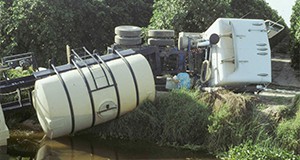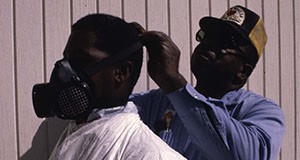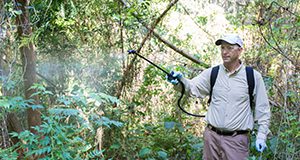In 1992, the US Environmental Protection Agency (EPA) issued a comprehensive regulation called the Worker Protection Standard for Agricultural Pesticides (WPS). The EPA has made several changes to the WPS since it was fully implemented in 1995. This five-page document will address determining responsibilities under the revised WPS. Written by Frederick M. Fishel and published by UF’s Agronomy Department, September 2017.
http://edis.ifas.ufl.edu/ag418
Tag: Pesticide Information Office
Worker Protection Standard: Respirators
On November 2, 2015, the EPA revised the WPS, making significant changes to the rule’s requirements. Most of the revised provisions became effective January 2, 2017; there are four provisions that are delayed until January 2, 2018. This four-page document will address respirator use under the revised WPS. Written by Frederick M. Fishel and published by the Agronomy Department and the Pesticide Information Office.
http://edis.ifas.ufl.edu/pi272
Pesticide Labeling: Protection of Pollinators
On May 29, 2015, the EPA published its Proposal to Mitigate Exposure to Bees from Acutely Toxic Pesticide Products. This seven-page fact sheet outlines the highlights from this policy and its proposed restrictions, which would prohibit applications of pesticide products that are acutely toxic to bees during bloom where honey bees are known to be present under contract for pollination services. Written by Frederick M. Fishel, James Ellis, and Gene McAvoy and published by the Agronomy Department.
edis.ifas.ufl.edu/pi271
Quick Reference Guide to the Worker Protection Standard (WPS) as Revised in 2015
The Worker Protection Standard (WPS) is a regulation originally issued by the US Environmental Protection Agency (EPA) in 1992 and most recently revised in 2015. This eight-page reference guide gives an overview of the 2015 revisions. Written by Frederick M. Fishel, and published by the Agronomy Department.
http://edis.ifas.ufl.edu/pi270
Worker Protection Standard: Training Workers and Handlers under the 2016 Revision Requirements
In 1992, the US Environmental Protection Agency (EPA) issued a comprehensive regulation called the Worker Protection Standard for Agricultural Pesticides (WPS). The EPA has made several changes to the WPS since it was fully implemented in 1995. On November 2, 2015, the EPA revised the WPS, making significant changes to the rule’s requirements. Most of the revised provisions will become effective January 2, 2017; there are four provisions that are delayed until January 2, 2018. This five-page fact sheet answers questions regarding changes made to the rules about how to train Workers and Handlers. Written by Frederick M. Fishel and published by the Agronomy Department.
http://edis.ifas.ufl.edu/pi268
Worker Protection Standard: Certified Crop Advisor Exemption
In 1992, the US Environmental Protection Agency (EPA) issued a comprehensive regulation called the Worker Protection Standard for Agricultural Pesticides (WPS). The EPA has made several changes to the WPS since it was fully implemented in 1995. On November 2, 2015, the EPA made significant changes to the rule’s requirements. Most of the revised provisions will become effective January 2, 2017 and there are four provisions that are delayed until January 2, 2018. This five-page fact sheet answers questions regarding changes made to the exemptions for Certified Crop Advisors. Written by Frederick M. Fishel and Tatiana Sanchez and published by the Agronomy Department.
http://edis.ifas.ufl.edu/pi265
Worker Protection Standard: Notification and Hazard Communication
In 1992, the US Environmental Protection Agency (EPA) issued a comprehensive regulation called the Worker Protection Standard for Agricultural Pesticides (WPS). The EPA has made several changes to the WPS since it was fully implemented in 1995. On November 2, 2015, the EPA made significant changes to the rule’s requirements. Most of the revised provisions will become effective January 2, 2017 and there are four provisions that are delayed until January 2, 2018. This five-page fact sheet answers questions regarding changes made to the rules about notification and hazard communication. Written by Frederick M. Fishel and Tatiana Sanchez, and published by the Agronomy Department.
http://edis.ifas.ufl.edu/pi266
Worker Protection Standard: Information at a Central Location

This three-page FAQ fact sheet answers questions about posting information at a central location per the regulations of the Worker Protection Standard (WPS).
Written by Frederick M. Fishel and Tatiana Sanchez and published by the Agronomy Department.
http://edis.ifas.ufl.edu/pi149
Worker Protection Standard: Owner and Immediate Family Exemption

This three-page FAQ fact sheet answers questions about the exemptions for owners and their immediate families in the Worker Protection Standard (WPS).
Written by Frederick M. Fishel and Tatiana Sanchez and published by the Agronomy Department.
http://edis.ifas.ufl.edu/pi264
Worker Protection Standard: Personal Protective Equipment (PPE) 2016
In 1992, the US Environmental Protection Agency (EPA) issued a comprehensive regulation called the Worker Protection Standard for Agricultural Pesticides (WPS). The EPA has made several changes to the WPS since it was fully implemented in 1995. On November 2, 2015, the EPA made significant changes to the rule’s requirements. Most of the revised provisions will become effective January 2, 2017 and there are four provisions that are delayed until January 2, 2018. This five-page fact sheet answers questions regarding changes made to the rules about Personal Protective Equipment (PPE). Written by Frederick M. Fishel and published by the Agronomy Department.
http://edis.ifas.ufl.edu/pi267
Worker Protection Standard: Application Exclusion Zone (AEZ)

The Worker Protection Standard (WPS) is a Federal regulation designed to protect agricultural workers (people involved in the production of agricultural plants) and pesticide handlers (people mixing, loading, or applying pesticides or doing other tasks involving direct contact with pesticides).The “Application Exclusion Zone” or AEZ is a new term used in the WPS rule; it refers to the area surrounding the pesticide application equipment. This three-page fact sheet explains this new rule. Written by Fred M. Fishel and Tatiana Sanchez and published by the Agronomy Department.
http://edis.ifas.ufl.edu/pi263
Pest Strips: You Have to Read the Fine Print

Pest strips are commonly sold at many retail outlets and are available to anyone for purchase. They are constructed of resin plastic with an insecticide that is gradually control-released over time as a vapor. This two-page fact sheets gives important tips on how to use pest strips correctly without creating a hazard.Written by Fred Fishel and published by the Agronomy Department.
http://edis.ifas.ufl.edu/pi262
Pesticide Emergencies: Fires and Spills

Although accidents and emergencies involving pesticides are rare, unfortunately they do occur. Pesticide fires or spills can result in water, soil, and air contamination; damage to plants; injury to livestock, wildlife, or pets; and can endanger the health of the applicator and other people. Those using pesticides mus be prepared to respond to fires and spills as emergencies and act promptly and correctly. This six-page fact sheet explains how to reduce fire and spill hazards and what to do if a fire or spill should occur. Written by Frederick M. Fishel, and published by the Agronomy Department.
http://edis.ifas.ufl.edu/pi258
Pesticides: Routes of Exposure

Pesticides can cause both short-term and long-term effects in humans. Human exposure to pesticides can happen through four major routes: through the mouth and digestive system, through the eyes, through the skin, or through the nose and respiratory system. This two-page fact sheet explains each route of pesticide exposure, providing information on how to reduce the risk of pesticide exposure and hazard. Written by Frederick M. Fishel, and published by the Agronomy Department.
http://edis.ifas.ufl.edu/pi260
Pesticide Labeling: Precautionary Statements

Precautionary statements found on pesticide labeling tell the user information about the toxicity, irritation, and sensitization hazards associated with the use of the pesticide. These labels also provide treatment instructions and information to reduce exposure potential. This five-page fact sheet describes the different types of statements found on pesticide labels, as well as the instructions for personal protective equipment, and first-aid treatments. This publication also contains several reference tables for pesticide labels and their meanings. Written by Frederick M. Fishel, and published by the Agronomy Department.
http://edis.ifas.ufl.edu/pi259
Pesticide Emergencies: Contingency Planning

In the event of a pesticide emergency, having a an emergency response plan can help protect the health and welfare of employees and the community, minimize environmental damage, and potentially reduce liability. The goal of contingency planning is to prevent emergencies; but if an emergency does occur, the contingency plan allows business owners and managers to react appropriately in order to minimize detrimental effects.This eleven-page fact sheet provides insight on how to develop a contingency plan for addressing emergencies where pesticides are involved. Written by Frederick M. Fishel, and published by the Agronomy Department.
http://edis.ifas.ufl.edu/pi257
A Summary of Revisions to the Worker Protection Standard: 2015

In 1992, the US Environmental Protection Agency (EPA) issued a comprehensive regulation called the Worker Protection Standard for Agricultural Pesticides (WPS). The WPS covers pesticides used in the outdoor and enclosed space production of plants on farms, forests, and nurseries, as well as greenhouses. The EPA has made several changes to the WPS since it was fully implemented in 1995. On November 2, 2015, the EPA revised the WPS, making significant changes to the rule’s requirements. This five-page fact sheet explains those changes. Written by Frederick M. Fishel, and published by the Agronomy Department.
http://edis.ifas.ufl.edu/pi261
First Aid for Pesticide Exposure

Pesticide poisoning is a commonly under-diagnosed illness. This five-page fact sheet describes how to recognize the early symptoms of pesticide exposure and provide basic first aid for the treatment of victims. This fact sheet explains how to provide initial treatment in the case of pesticide exposure on the skin, in the eye, through inhalation, and in the mouth or swallowed. Written by Frederick M. Fishel, and published by the Agronomy Department.
http://edis.ifas.ufl.edu/pi256
Pesticide Storage: Keep It in the Container
 Accidents happen quickly, and so do accidents with pesticides. Anyone storing pesticides, especially in the presence of children, needs to take precautions by keeping them in their proper, original containers. Several people have died when they unknowingly drank pesticides from containers that originally held soda, other beverages, or foodstuffs. In particular, the herbicide paraquat is highly toxic to humans; one small accidental sip can be fatal, and there is no antidote. This 3-page fact sheet was written by Fred Fishel, and published by the UF Department of Agronomy, May 2015. (Photo: Fred Fishel)
Accidents happen quickly, and so do accidents with pesticides. Anyone storing pesticides, especially in the presence of children, needs to take precautions by keeping them in their proper, original containers. Several people have died when they unknowingly drank pesticides from containers that originally held soda, other beverages, or foodstuffs. In particular, the herbicide paraquat is highly toxic to humans; one small accidental sip can be fatal, and there is no antidote. This 3-page fact sheet was written by Fred Fishel, and published by the UF Department of Agronomy, May 2015. (Photo: Fred Fishel)
http://edis.ifas.ufl.edu/pi255
Pool Chemicals and Personal Safety
 Pool chemicals are among the most common household substances and are used to protect health in recreational waters. Pool chemicals containing chlorine safeguard against recreational-water illnesses caused by disease-causing pathogens, such as the diarrhea-causing Cryptosporidium. They also enhance disinfection by regulating water pH. But even though these materials are regularly handled by homeowners, most don’t ever realize that they are handling pesticides. This 3-page fact sheet was written by Fred Fishel, and published by the UF Department of Agronomy, September 2014.
Pool chemicals are among the most common household substances and are used to protect health in recreational waters. Pool chemicals containing chlorine safeguard against recreational-water illnesses caused by disease-causing pathogens, such as the diarrhea-causing Cryptosporidium. They also enhance disinfection by regulating water pH. But even though these materials are regularly handled by homeowners, most don’t ever realize that they are handling pesticides. This 3-page fact sheet was written by Fred Fishel, and published by the UF Department of Agronomy, September 2014.
http://edis.ifas.ufl.edu/pi253



